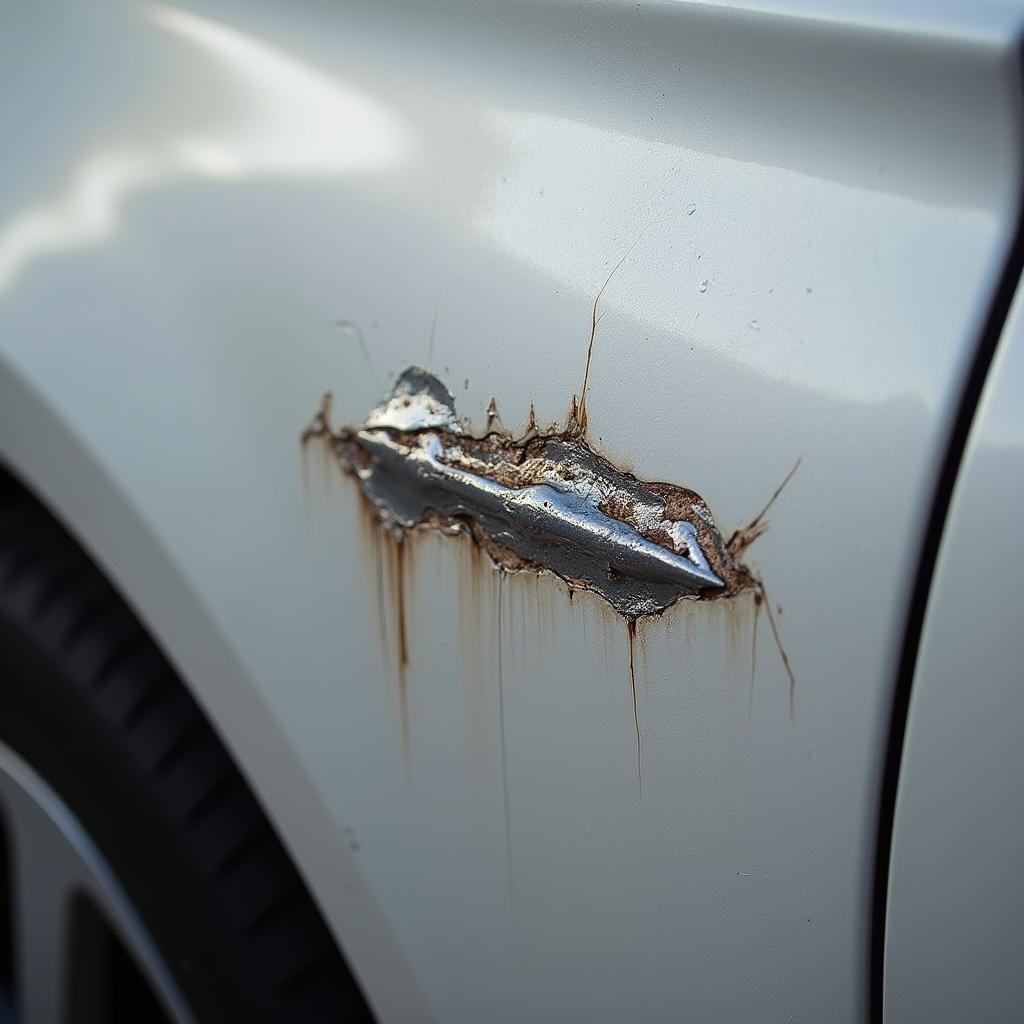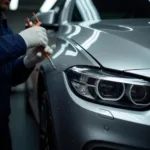Discovering a key scratch on your car’s pristine paint job can be disheartening. This unfortunate act of vandalism, whether intentional or accidental, can leave your car looking worse for wear. But don’t despair! This guide will walk you through how to repair key scratches on car paint, empowering you to restore your car’s appearance without breaking the bank.
Assessing the Damage: Is it Just a Scratch or Something More?
Before diving into the repair process, it’s crucial to assess the severity of the damage. Not all scratches are created equal.
- Clear Coat Scratches: These are the most superficial type, affecting only the clear coat layer that protects your car’s paint.
- Paint Scratches: These go deeper, penetrating the color layer of your car’s paint. You’ll know it’s a paint scratch if you see a different color underneath.
- Deep Scratches: These cut through the primer and expose the bare metal, demanding more extensive repair.
 Deep Car Scratch
Deep Car Scratch
DIY Key Scratch Repair: What You’ll Need
For this guide, we’ll focus on repairing clear coat and minor paint scratches. You’ll need the following:
- Car Wash Soap: Thoroughly cleaning the area is essential before starting any repair.
- Microfiber Cloths: These are perfect for gentle cleaning and buffing.
- Rubbing Compound: This abrasive paste helps to remove scratches and polish the surface.
- Polishing Compound: This follows the rubbing compound to restore shine and luster.
- Wax: A final layer of wax protects the repaired area and enhances the shine.
How to Fix Key Scratches on Your Car: A Step-by-Step Guide
- Wash and Dry: Start by washing your car thoroughly, paying extra attention to the scratched area. Use a microfiber cloth to dry it completely.
- Apply Rubbing Compound: Apply a small amount of rubbing compound to a clean microfiber cloth. Gently rub the compound onto the scratch using back-and-forth motions, following the direction of the scratch.
- Buff and Inspect: After several passes, wipe away the excess compound and inspect the scratch. Repeat the process if the scratch is still visible.
- Polish the Area: Apply a polishing compound to a fresh microfiber cloth and work it onto the area using circular motions. This will remove any remaining residue from the rubbing compound and restore the paint’s shine.
- Wax for Protection: Once you’re satisfied with the results, apply a layer of car wax to the repaired area. Waxing protects your hard work and adds a layer of gloss to the finish.
When to Call in the Pros
While DIY solutions work well for minor key scratches, deeper scratches often require professional attention. If you see exposed metal or the DIY approach doesn’t yield satisfactory results, consider seeking help from a professional car detailer or body shop. They have the tools and expertise to handle more severe damage, ensuring a flawless finish. For more serious paint damage, learn more about on site car paint repair.
Preventing Future Key Scratches: Proactive Measures
Prevention is always better than cure. Here are some tips to safeguard your car from future key scratches:
- Park Smartly: Opt for well-lit areas and avoid parking too close to other vehicles.
- Invest in a Car Cover: If you frequently park in areas prone to vandalism, a car cover provides an extra layer of protection.
- Car Security System: Consider installing a car security system with an alarm to deter potential vandals.
Conclusion
Key scratches might be an unpleasant sight, but they don’t have to be a permanent blemish on your car’s appearance. With the right approach and a bit of effort, you can repair minor scratches yourself, restoring your car’s paint job to its former glory. Remember to accurately assess the damage, follow the steps diligently, and don’t hesitate to seek professional help when needed. By taking proactive measures to protect your car, you can minimize the risk of future key scratches and keep your car looking its best for years to come. For further guidance on car paint repair, refer to our comprehensive guide on how to repair damaged paint on a car.


